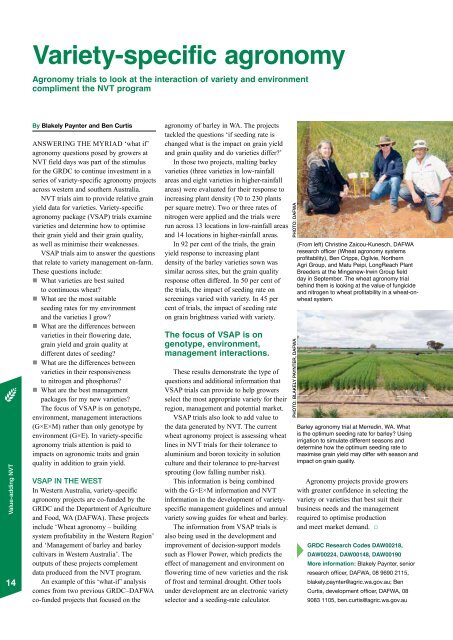NatioNal variety trials supplemeNt - Grains Research ...
NatioNal variety trials supplemeNt - Grains Research ...
NatioNal variety trials supplemeNt - Grains Research ...
You also want an ePaper? Increase the reach of your titles
YUMPU automatically turns print PDFs into web optimized ePapers that Google loves.
Variety-specific agronomy<br />
Agronomy <strong>trials</strong> to look at the interaction of <strong>variety</strong> and environment<br />
compliment the NVT program<br />
Value-adding NVT<br />
14<br />
By Blakely Paynter and Ben Curtis<br />
Answering the myriad ‘what if’<br />
agronomy questions posed by growers at<br />
NVT field days was part of the stimulus<br />
for the GRDC to continue investment in a<br />
series of <strong>variety</strong>-specific agronomy projects<br />
across western and southern Australia.<br />
NVT <strong>trials</strong> aim to provide relative grain<br />
yield data for varieties. Variety-specific<br />
agronomy package (VSAP) <strong>trials</strong> examine<br />
varieties and determine how to optimise<br />
their grain yield and their grain quality,<br />
as well as minimise their weaknesses.<br />
VSAP <strong>trials</strong> aim to answer the questions<br />
that relate to <strong>variety</strong> management on-farm.<br />
These questions include:<br />
• What varieties are best suited<br />
to continuous wheat<br />
• What are the most suitable<br />
seeding rates for my environment<br />
and the varieties I grow<br />
• What are the differences between<br />
varieties in their flowering date,<br />
grain yield and grain quality at<br />
different dates of seeding<br />
• What are the differences between<br />
varieties in their responsiveness<br />
to nitrogen and phosphorus<br />
• What are the best management<br />
packages for my new varieties<br />
The focus of VSAP is on genotype,<br />
environment, management interactions<br />
(G×E×M) rather than only genotype by<br />
environment (G×E). In <strong>variety</strong>-specific<br />
agronomy <strong>trials</strong> attention is paid to<br />
impacts on agronomic traits and grain<br />
quality in addition to grain yield.<br />
VSAP in the west<br />
In Western Australia, <strong>variety</strong>-specific<br />
agronomy projects are co-funded by the<br />
GRDC and the Department of Agriculture<br />
and Food, WA (DAFWA). These projects<br />
include ‘Wheat agronomy – building<br />
system profitability in the Western Region’<br />
and ‘Management of barley and barley<br />
cultivars in Western Australia’. The<br />
outputs of these projects complement<br />
data produced from the NVT program.<br />
An example of this ‘what-if’ analysis<br />
comes from two previous GRDC–DAFWA<br />
co-funded projects that focused on the<br />
agronomy of barley in WA. The projects<br />
tackled the questions ‘if seeding rate is<br />
changed what is the impact on grain yield<br />
and grain quality and do varieties differ’<br />
In those two projects, malting barley<br />
varieties (three varieties in low-rainfall<br />
areas and eight varieties in higher-rainfall<br />
areas) were evaluated for their response to<br />
increasing plant density (70 to 230 plants<br />
per square metre). Two or three rates of<br />
nitrogen were applied and the <strong>trials</strong> were<br />
run across 13 locations in low-rainfall areas<br />
and 14 locations in higher-rainfall areas.<br />
In 92 per cent of the <strong>trials</strong>, the grain<br />
yield response to increasing plant<br />
density of the barley varieties sown was<br />
similar across sites, but the grain quality<br />
response often differed. In 50 per cent of<br />
the <strong>trials</strong>, the impact of seeding rate on<br />
screenings varied with <strong>variety</strong>. In 45 per<br />
cent of <strong>trials</strong>, the impact of seeding rate<br />
on grain brightness varied with <strong>variety</strong>.<br />
The focus of VSAP is on<br />
genotype, environment,<br />
management interactions.<br />
These results demonstrate the type of<br />
questions and additional information that<br />
VSAP <strong>trials</strong> can provide to help growers<br />
select the most appropriate <strong>variety</strong> for their<br />
region, management and potential market.<br />
VSAP <strong>trials</strong> also look to add value to<br />
the data generated by NVT. The current<br />
wheat agronomy project is assessing wheat<br />
lines in NVT <strong>trials</strong> for their tolerance to<br />
aluminium and boron toxicity in solution<br />
culture and their tolerance to pre-harvest<br />
sprouting (low falling number risk).<br />
This information is being combined<br />
with the G×E×M information and NVT<br />
information in the development of <strong>variety</strong>specific<br />
management guidelines and annual<br />
<strong>variety</strong> sowing guides for wheat and barley.<br />
The information from VSAP <strong>trials</strong> is<br />
also being used in the development and<br />
improvement of decision-support models<br />
such as Flower Power, which predicts the<br />
effect of management and environment on<br />
flowering time of new varieties and the risk<br />
of frost and terminal drought. Other tools<br />
under development are an electronic <strong>variety</strong><br />
selector and a seeding-rate calculator.<br />
photo: Blakely Paynter, DAFWA photo: DAFWA<br />
(From left) Christine Zaicou-Kunesch, DAFWA<br />
research officer (Wheat agronomy systems<br />
profitability), Ben Cripps, Ogilvie, Northern<br />
Agri Group, and Matu Peipi, LongReach Plant<br />
Breeders at the Mingenew-Irwin Group field<br />
day in September. The wheat agronomy trial<br />
behind them is looking at the value of fungicide<br />
and nitrogen to wheat profitability in a wheat-onwheat<br />
system.<br />
Barley agronomy trial at Merredin, WA. What<br />
is the optimum seeding rate for barley Using<br />
irrigation to simulate different seasons and<br />
determine how the optimum seeding rate to<br />
maximise grain yield may differ with season and<br />
impact on grain quality.<br />
Agronomy projects provide growers<br />
with greater confidence in selecting the<br />
<strong>variety</strong> or varieties that best suit their<br />
business needs and the management<br />
required to optimise production<br />
and meet market demand. □<br />
GRDC <strong>Research</strong> Codes DAW00218,<br />
DAW00224, DAW00148, DAW00190<br />
More information: Blakely Paynter, senior<br />
research officer, DAFWA, 08 9690 2115,<br />
blakely.paynter@agric.wa.gov.au; Ben<br />
Curtis, development officer, DAFWA, 08<br />
9083 1105, ben.curtis@agric.wa.gov.au

















